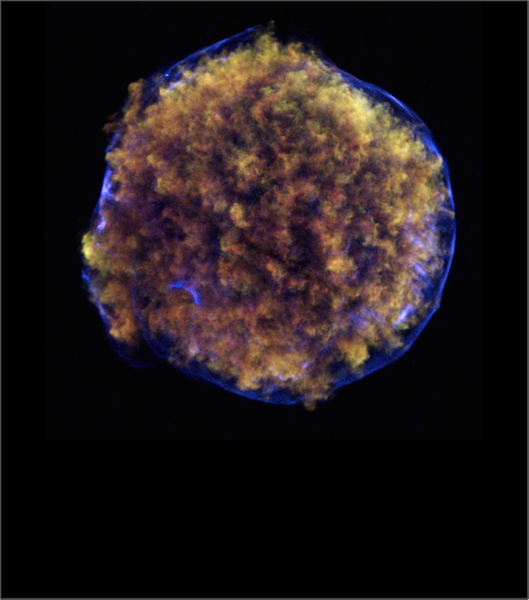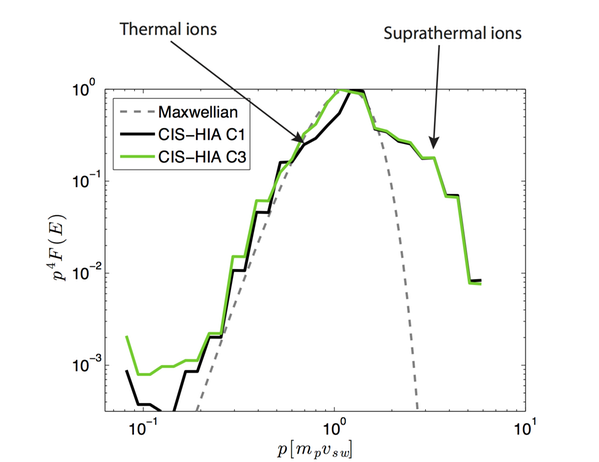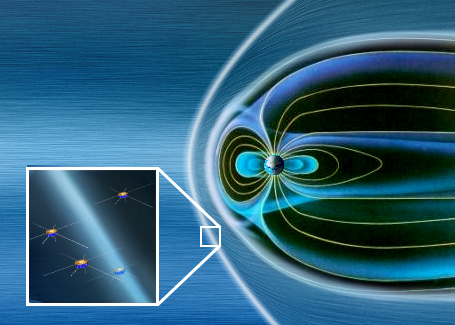Collisionless shocks
Shock waves
Shock waves are found in regular fluids like air and water here on Earth. Shock waves arise when the flow velocity of an object relative to the fluid is greater than the speed of sound. Shocks are formed for example when an airplane breaks the sound barrier, which causes a sonic boom. Shocks can also be created by running water from a tap into a sink. A termination shock is then formed where the fast water flow transitions into slow flow.

Tycho's Supernova Remnant in x-rays. Image: NASA/CXC/Rutgers/J.Warren & J.Hughes et al from Wikimedia commons
Shocks in collisionless plasmas
Shocks are also found in a wide variety of plasmas in the universe. These plasmas are generally collisionless, which means that energy is dissipated via wave–particle interaction instead of particle–particle collisions. Some examples of shocks in collisionless plasma are shocks around supernova remnants and the Earth's bow shock, which forms when the solar wind encounters the magnetosphere of the Earth.
An important aspect of collisionless shocks is the orientation of the magnetic field relative to the shock. A shock where the magnetic field forms an angle of less than 45 degrees with the normal of the shock surface is called quasi-parallel. Otherwise, it is called quasi-perpendicular. While quasi-perpendicular shocks are characterized by a sharp transition, quasi-parallel shock transitions are usually extended far in space and are highly turbulent.
Particle acceleration
Shocks in space plasmas are capable of accelerate charged particles to extremely high energies. For example cosmic rays are believed to be formed at shock transitions in supernova remnants. The particles are accelerated through a process called diffusive shock acceleration. However, the particles that go through this process must have higher than thermal energies (suprathermal). Particles must first be accelerated to suprathermal energies before they can gain even higher energies.

Plot showing ion distribution at the quasi-parallel bow shock.
We study, in detail how particles are accelerated to suprathermal energies, and being injected to diffusive shock acceleration. To do this, we use the Earth's bow shock as a plasma physics laboratory. We use data from the four European Cluster satellites to study ion acceleration with high temporal and spatial resolution. For example, we study how ions are being accelerated by reflection off magnetic structures in the solar wind. In the future, the newly launched MMS satellites will hopefully provide even higher resolution field and particle data, which will be useful in studying acceleration processes in shocks.

Cluster satellites in Earth's bow shock. Image: ESA/AOES Medialab
Contact: Andris Vaivads, Yuri Khotyaintsev, Andreas Johlander
Further reading
http://www.space.irfu.se/exjobb/2014_andreas_johlander/
Burgess, D., et al. (2005), Quasi-parallel shock structure and processes,
Space Sci. Rev., 118, 205–222, doi:10.1007/s11214-005-3832-3.
Behlke, R., M. André, S. C. Buchert, A. Vaivads, A. I. Eriksson, E. A. Lucek, and A. Balogh: 2003, ‘Multi-point electric field measurements of Short Large-Amplitude Magnetic Structures (SLAMS) at the Earth’s quasi-parallel bow shock’. Geophys. Res. Lett. 30, 1177, doi:10.1029/2002GL015871.
